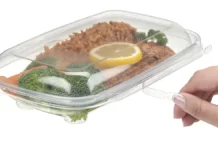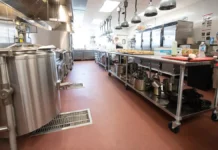
Article contributed by Nancy Zafrani, Oz Moving & Storage
After months (or maybe even years) of searching, you’ve finally chosen the perfect space to relocate your restaurant!
You’re excited to take your business to the next level. However, you’re probably also feeling stressed about transferring your equipment and ingredients from one commercial kitchen to another.
Not only do you have to worry about moving high-value and fragile items, but you also have to find a way to streamline the move so it doesn’t interfere with your business operations.
This guide features practical strategies you can use to simplify the moving process and relocating your commercial kitchen with ease.
Challenges of Relocating Your Commercial Kitchen
It doesn’t matter if you run a corner cafe or a five-star restaurant. Relocating your commercial kitchen is tricky. Here are some of the most frequently cited problems you might run into during this process:
- Timing it right: You need to pick a time to move that causes the least number of interruptions to your business (such as early in the day before you open or on a day when you’re typically closed).
- Informing customers: Your customers need plenty of time to adjust to the idea of their favorite restaurant moving. They also need to know where you’re moving so they can continue visiting regularly.
- Moving heavy and high-value equipment: Many commercial kitchen appliances and items are large, heavy, and expensive. You’ll need to plan the move carefully to avoid accidents.
- Choosing movers: Another important part of planning your move is choosing the right moving professionals. You should look for people who have experience with commercial kitchen moves to ensure they know how to move your equipment correctly.
Tips for Simple Commercial Kitchen Relocation
To overcome the challenges listed above and simplify the overall kitchen relocation process, try these tips:
Start Planning Early
Even the smallest restaurants require planning for a streamlined kitchen move. The sooner you begin planning, the less stressful the move will likely be. Begin by creating a timeline.
To do this, choose your moving date (try to pick a date during a slower time to minimize interruptions) and work backward from there. Then, set deadlines for different tasks — hiring movers, procuring moving supplies, packing certain items, etc. — to avoid being overwhelmed and ensure you don’t forget anything important.
Make a plan for sharing the news with your customers, too. Give them plenty of notice by posting on social media, displaying signs around the restaurant, etc., so that everyone knows where you’re going, when you’re leaving, and when you’ll reopen.
Research Permits and Regulations for the New Location
If you’re relocating to a new city or state, make sure you’re aware of and have the proper permits and licenses. Taking care of this important paperwork early will ensure a smoother move and save you from extra stress (and potential fines) when you arrive at your new location.
Choose the Right Moving Team
Look for a moving team that specializes in (or at least has prior experience with) commercial kitchen moves. Ideally, they will be familiar with the type of equipment you need to move and will know how to transport it safely and efficiently.
Don’t delay looking for professional movers, either. The best teams will book out weeks or months in advance, so get in touch as soon as possible to ensure they can help you with your move.
Conduct a Thorough Inventory Assessment
Before you start packing, take inventory of all your belongings. What equipment and items are you bringing to your new kitchen — and how many of each do you have?
Taking inventory now will help during the unpacking process because you’ll know if anything is missing. As a result, your chef won’t realize during dinner service that you’re missing a key piece of equipment needed to prepare their signature dish.
Package and Label Equipment Carefully
Another important aspect of packing any kitchen is clearly labeling every box. Careful labeling ensures that you know what’s in each container and helps you unpack more efficiently.
Be sure to follow best packing practices, too. For example, use packing paper or bubble wrap for dishes and glassware. Pack heavy items in smaller boxes and lighter items in larger ones, as well.
Post-Move Evaluation
You’re not finished just because you’ve moved all your belongings from one commercial kitchen to another. The next step is to unpack and get settled in so you can start serving your customers the food and beverages they’ve come to know and love.
The following tips will help you evaluate the new space and set your kitchen up as quickly as possible:
Clean Before Moving In
Make sure your new commercial kitchen is clean before you start hauling in boxes.
You might even want to consider hiring a professional cleaning team to come in and take care of the space before you arrive and unpack. That way, you can trust that everything is sanitized and ready for your team to start cooking.
Create an Unpacking and Setup Plan
Planning for the unpacking and setup phase is just as important as packing for the move itself.
Decide what items you want to unpack first and where you’re going to store certain ingredients and equipment, etc. Then, communicate this plan to your team (or the movers if they’re going to help with unpacking) so everyone is on the same page.
Take Time for Testing and Quality Assurance
Don’t unpack and then jump straight into the grand opening dinner for your new location (that’s a lot of extra stress for you and your staff).
Instead, give yourself time to hook up and test all appliances and equipment. That way, if you run into any problems, you’ll have a chance to fix them before you start serving customers again.
Set Yourself Up for a Seamless Commercial Kitchen Move
Moving your restaurant and commercial kitchen to a new location can be stressful. However, if you take the time to plan, pack everything properly, and create a detailed setup strategy, the process will go much more smoothly.
Follow the guidelines shared above to streamline your restaurant’s relocation and enjoy a successful reopening.
 Nancy Zafrani is the experienced General Manager of Oz Moving & Storage, with 30 years in the industry and a lifetime of knowledge as a New Yorker. She helped grow the company from 3 employees to 200 with 50 trucks and locations across the US. Her experience and organizational skills have led to over 500,000 successful moves. She is proud to lead a company that provides the best possible moving experience.
Nancy Zafrani is the experienced General Manager of Oz Moving & Storage, with 30 years in the industry and a lifetime of knowledge as a New Yorker. She helped grow the company from 3 employees to 200 with 50 trucks and locations across the US. Her experience and organizational skills have led to over 500,000 successful moves. She is proud to lead a company that provides the best possible moving experience.

























